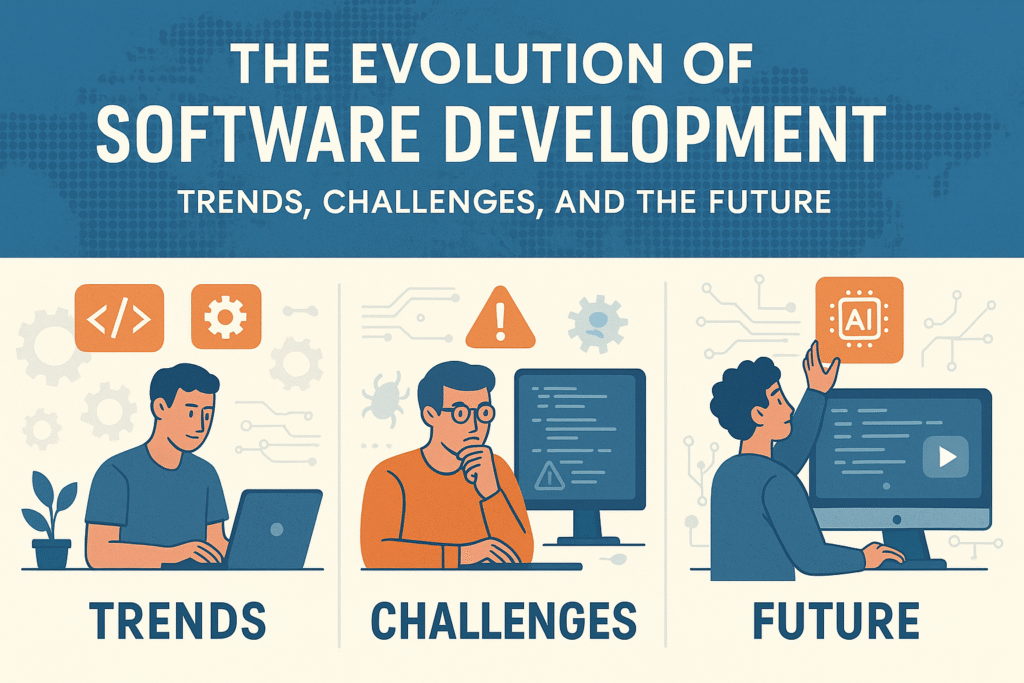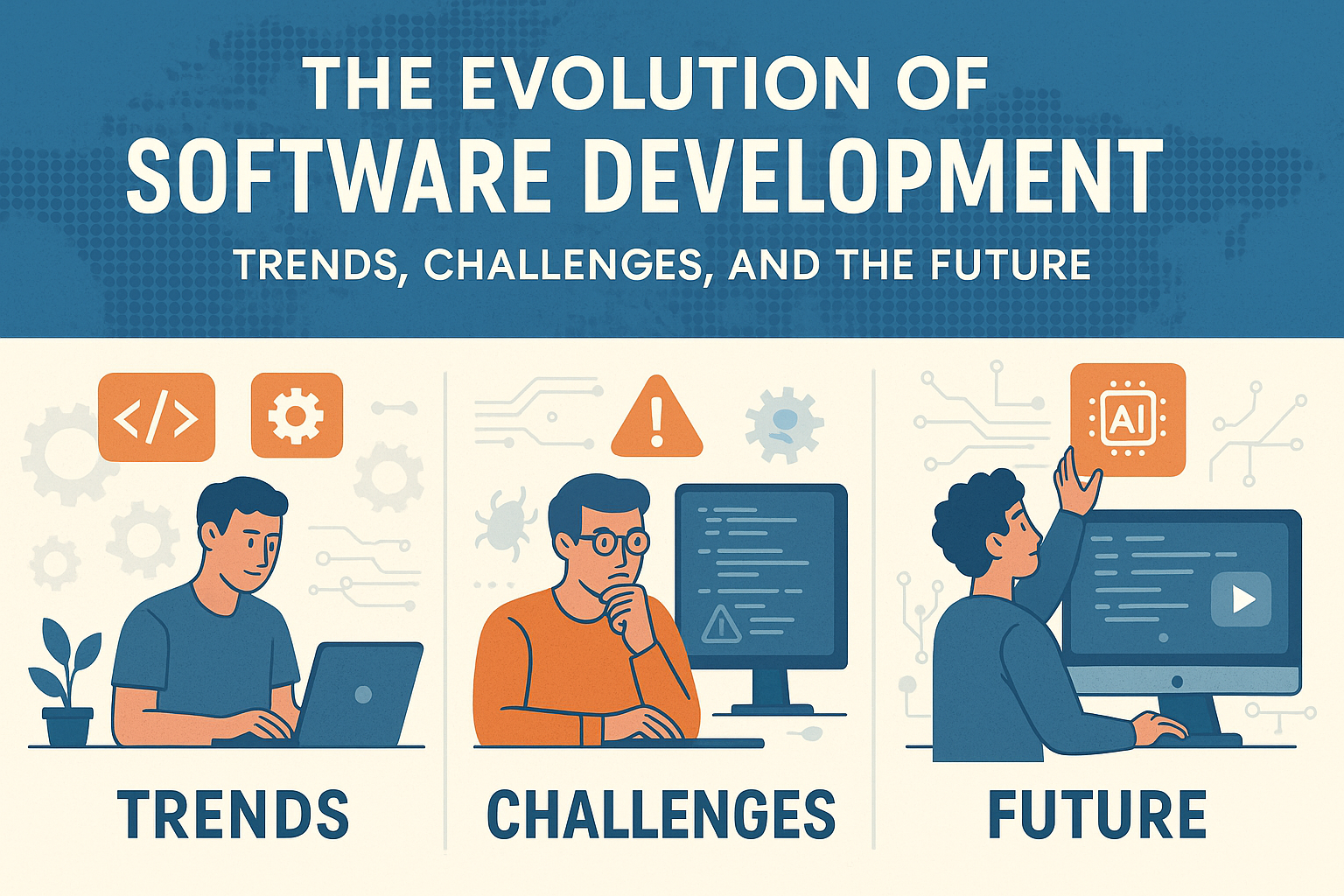Software development has undergone a dramatic transformation over the past few decades. From the early days of punch cards and mainframes to today’s AI-driven automation, the journey of software development reflects the growth of technology, business needs, and human ingenuity. Today, developers are expected not just to write code but to create scalable, secure, and user-friendly systems in a fast-paced, ever-changing environment.
This blog explores the evolution of software development, current trends, ongoing challenges, and what the future might hold.

A Brief History of Software Development
The concept of software predates modern computing. Alan Turing proposed the idea of a universal machine in the 1930s, and by the mid-20th century, the first actual software programs were developed to run on mainframe computers.
- 1950s–1970s: This era was defined by low-level programming languages like Assembly and Fortran. Programs were often written specifically for the hardware they ran on.
- 1980s–1990s: The rise of personal computers brought programming to a broader audience. Languages like C and C++ became dominant. Software development became more structured with methodologies like Waterfall.
- 2000s–2010s: The explosion of the internet introduced web development. Agile and DevOps revolutionized how teams work. Open-source software and cloud computing began reshaping the landscape.
- 2020s–present: AI-assisted development, containerization, serverless architectures, and the widespread use of JavaScript frameworks have taken center stage.
Key Trends in Modern Software Development
1. Agile and DevOps Culture
Agile methodologies shifted development from rigid, documentation-heavy workflows to flexible, iterative cycles. DevOps took this further by integrating operations and development teams to improve deployment speed and quality. Together, they enable continuous integration (CI) and continuous delivery (CD), reducing time-to-market.
2. Cloud-Native Development
Cloud computing changed everything. Today, software is developed for scalability and resilience in the cloud. Platforms like AWS, Azure, and Google Cloud provide services that handle infrastructure, databases, monitoring, and more. Cloud-native technologies like Kubernetes, Docker, and serverless functions are now part of everyday development.
3. AI and Machine Learning Integration
Modern applications often include AI capabilities, such as natural language processing, image recognition, or predictive analytics. This integration requires knowledge of machine learning frameworks, data engineering, and responsible AI practices. Tools like TensorFlow, PyTorch, and OpenAI APIs are commonly used.
4. Low-Code and No-Code Platforms
Low-code platforms (like OutSystems and Mendix) and no-code platforms (like Bubble and Glide) allow users to build applications with minimal programming knowledge. These tools enable faster prototyping and empower business users, though they may lack the flexibility of custom code.
5. Microservices Architecture
Breaking down monolithic applications into microservices allows teams to develop, test, and deploy independently. Each microservice handles a specific function and communicates with others via APIs. While powerful, it introduces challenges related to coordination, monitoring, and security.
6. Security as a First-Class Citizen
Security is no longer an afterthought. DevSecOps emphasizes incorporating security at every step of the development lifecycle. With increasing cyber threats, practices like threat modeling, static code analysis, and automated security testing are essential.
7. Developer Experience (DX) and Tooling
The ecosystem of tools has exploded—VS Code, GitHub Copilot, Postman, Figma, Docker, etc. Developers now have access to rich IDEs, powerful CI/CD pipelines, and collaborative platforms. Enhancing the developer experience directly impacts productivity and code quality.
Major Challenges in Software Development
Despite the innovation, software development remains a demanding field. Here are some common challenges developers and teams face today:
1. Rapid Technological Change
Keeping up with the constantly evolving technology stack is difficult. Developers must continuously learn new frameworks, tools, and languages, which can lead to fatigue and skill gaps within teams.
2. Scalability and Performance
Building applications that scale efficiently as user demand grows is a complex problem. Developers must consider load balancing, database optimization, caching, and distributed systems design.
3. Security and Compliance
Applications must comply with regulations like GDPR, HIPAA, and PCI DSS, depending on the domain. Failure to secure data properly can lead to breaches and financial penalties.
4. Cross-Platform Compatibility
Users access software from diverse platforms—iOS, Android, web browsers, desktops. Ensuring consistent functionality and experience across all platforms requires thoughtful design and testing.
5. Testing and Quality Assurance
Automated testing, code coverage, integration tests, and user acceptance testing are all crucial. However, maintaining test suites and ensuring they catch real issues without producing false positives is challenging.
6. Legacy Systems Integration
Many organizations still rely on legacy systems that are critical to their operations. Integrating modern applications with these older systems often requires complex workarounds and custom code.
7. Team Collaboration and Communication
With remote and distributed teams becoming the norm, communication challenges have multiplied. Misunderstandings, unclear specifications, and siloed work can lead to delays and bugs.
Future of Software Development
The future of software development looks promising and complex. Here are some anticipated trends and directions for the next decade:
1. AI-Driven Development
AI will increasingly assist with code generation, bug detection, and even architecture decisions. Tools like GitHub Copilot and Amazon CodeWhisperer show what’s possible. However, ethical concerns and the need for human oversight remain.
2. Quantum Computing Integration
Though still experimental, quantum computing could revolutionize fields like cryptography, optimization, and simulation. Developers will eventually need to learn quantum programming concepts and languages like Q# or Qiskit.
3. Universal Language Models (ULMs)
Advanced language models will act as coding assistants, converting plain English into efficient code or auto-documenting software. These tools will likely become more deeply integrated into IDEs.
4. Sustainable Software Engineering
Energy efficiency and carbon footprint will become considerations in software design. Developers will be encouraged to write “green code,” minimizing energy consumption especially in large-scale applications and AI models.
5. Augmented and Virtual Reality (AR/VR)
AR/VR development will become more mainstream, especially for gaming, education, remote work, and e-commerce. Developers will need to gain expertise in 3D graphics, spatial computing, and UX design for immersive experiences.
6. Ethical and Inclusive Design
Inclusive software design, considering accessibility, bias reduction, and ethical AI use, will be prioritized. Regulations may mandate fair algorithms, transparency, and responsible data use.
7. Hyperautomation and RPA
Robotic Process Automation (RPA) and AI-driven decision-making will reduce human intervention in repetitive tasks. Developers will build and manage these automation flows, blending traditional coding with business logic.
Essential Skills for Modern Developers
To stay competitive, software developers need to focus on both technical and soft skills:
Technical Skills:
- Proficiency in at least one modern programming language (e.g., JavaScript, Python, Go, Rust)
- Understanding of data structures, algorithms, and system design
- Familiarity with DevOps tools (e.g., Jenkins, GitHub Actions)
- Cloud computing knowledge (AWS, Azure, or GCP)
- API development and integration
- Secure coding practices
Soft Skills:
- Problem-solving and critical thinking
- Communication and collaboration
- Adaptability to new tools and technologies
- Project management fundamentals (Scrum, Kanban)
- User-centric design thinking
Final Thoughts
Software development has come a long way, growing from a niche technical practice to a foundational aspect of modern society. The demand for quality software continues to rise, pushing developers to innovate while maintaining security, performance, and usability.
While tools and frameworks may change, the core of software development—problem-solving, logic, and creativity—remains the same. Whether you’re a seasoned developer or just starting out, embracing lifelong learning and adaptability is key.
The future will undoubtedly bring more automation, intelligent assistance, and abstraction. But ultimately, software development will continue to be a human-driven discipline, guided by empathy, curiosity, and a desire to make technology better for everyone.

Leave a Reply